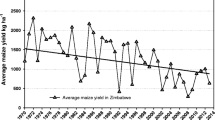Abstract
Farm lands of resource-poor communities in South Africa are depleted of nutrients due to continuous mono-cropping, limited use of fertilisers, and sometimes leaching caused by high rainfall. Despite the well-known advantages of biological nitrogen fixation (BNF) in cropping systems, less than 10% of the grain crops planted annually in these areas are legumes. Using a participatory research and development approach, resource-poor farmers were introduced to conservation agriculture (CA) practices, including BNF, that promoted zero (or reduced) tillage, increased retention of soil cover, as well as crop diversification. Because crop rotation and intercropping of legumes with cereals are known to contribute to soil fertility while enhancing food security, resource-poor farmers from various Provinces in South Africa were trained on the benefits of legume culture for eight years. As a result, these resource-poor farmers did not only get training in inoculation techniques, but were also supplied with inoculants for use on their farms. Data collected from Farmers Demonstration Trials at Belvedere, Dumbarton and Lusikisiki, showed that the grain and fodder yield of maize planted after legumes, and maize intercropped with legumes, were comparable to those of maize receiving high N fertilizer dose (i.e. 54 kg N at planting and 54 kg N as top-dressing). The same data further showed thatRhizobium inoculation, when combined with application of low levels of P and K, significantly increased crop yields within farmers’ trial plots. BNF therefore offers a great opportunity for resource-poor farmers in South Africa to increase their crop yields and thus improve the quality of their livelihoods through the adoption of affordable and sustainable biological technologies that enhance soil fertility.
Similar content being viewed by others
References
Bezner, K.R., Snapp, S., Chirwa, M., Shumba, L., and Msachi, R. 2007. Participatory research on legume diversification with Malawian smallholder fanners for improved human nutrition and soil fertility.Experimental Agriculture 43: 437–453.
Jansen van Rensburg, H.G. 2002. Demonstration and assessment of sustainable land management practices in the Mlondozi district of Mpumalanga. Final Report for Mlondozi Landcare Project. ISCW Report No. GW/A/2003/05.
Kolbe, D.A. 1984.Experiental Learning: Experience as the Source of Learning and Development. Prentice-Hall, Englewood Cliffs, NJ
Röling, N. 1997. The soft side of land: socio-economic sustainability of land use systems. In:Proceedings of the International Conference on Geo-information for Sustainable Land Management, 17–21 August, Enschede, The Netherlands. ITC Journal 1997-3/4.
Sakurai, T. 2002. Quantitative analysis of collective action: Methodology and challenges. Paper presented at the CAPRI Workshop on Collective Action, Nairobi, 25–28 February 2002. Available online at:www.capri.cgiar.org/pdf/ca sakuria.pdf
Smith, H.J., Trytsman, G., Bloem, J.F., Everson, T., and Mthethwa, S. 2005. Development and implementation of sustainable land management practices in the Bergville district of the KwaZulu-Natal Province. Fourth progress report. Bergville/Emmaus Landcare project. ARC-ISCW Report numberGW/A/2005/04.
Smith, H.J. 2006. Development of a systems model facilitating action research with resource-poor farmers for sustainable management of natural resources. PhD Thesis. University of the Free State, Bloemfontein.
Steyn, C.S. 2005. Developmentand implementation of sustainable land management practices in the Lusikisiki district of the Eastern Cape Province. Progress report, Lusikisiki Landcare project. ARC-ISCWReport number GW/A/2002/01.
Strijdom, B.W. 1998. South African studies on biological nitrogen fixation systems and the exploitation of the nodule bacteriumlegume symbiosis.South African Journal of Science 94: 11–23.
Trytsman, G. 2008. Intensification to promote sustainable farming systems in rural development applying conservation agricultural principles. Dissertation, Master in Sustainable Agriculture, University of the Free State, South Africa.
Author information
Authors and Affiliations
Corresponding author
Additional information
Posthumous
Rights and permissions
About this article
Cite this article
Bloem, J.F., Trytsman, G. & Smith, H.J. Biological nitrogen fixation in resource-poor agriculture in South Africa. Symbiosis 48, 18–24 (2009). https://doi.org/10.1007/BF03179981
Received:
Accepted:
Issue Date:
DOI: https://doi.org/10.1007/BF03179981




